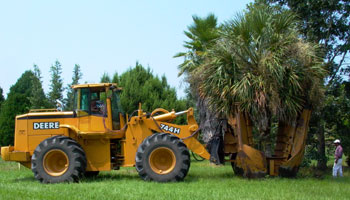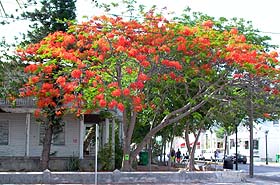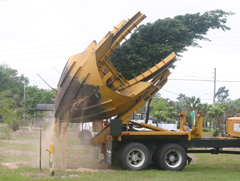Home > Planting trees > Transplanting
Transplanting
 Transplanting
large trees up to about 16 inches trunk diameter is executed with large tree
spades on a regular basis (see photo, right). Transplanting very large established
trees is becoming more popular in certain communities, especially associated
with new developments near existing trees.
Transplanting
large trees up to about 16 inches trunk diameter is executed with large tree
spades on a regular basis (see photo, right). Transplanting very large established
trees is becoming more popular in certain communities, especially associated
with new developments near existing trees.
Extremely large trees can also be moved by the right professionals. To enhance the likelihood of success, do this: Irrigate the tree regularly for two to four weeks before root pruning. Hire a qualified consulting arborist to evaluate the situation; air spade the roots in the area where roots will be severed to remove soil. Make clean cuts with a chain saw and cover with soil within one hour. Irrigate this area daily for several months (less in dormant season and rainy weather) then three times a week for a year to help roots generate from cuts; roots may or may not generate from the cuts. Irrigate the remaining soil under the canopy to maintain water potential of less than 20 bars on twigs in the upper canopy at mid day (1 pm). If water potential gets to the high 20s or low 30s (live oak) or upper teens to low 20s (red maple) during mid day the tree is likely to decline in health.
 Moving large trees can be a good idea in some instances
provided a plan is in place to execute the extreme care required to keep
these trees alive. The care plan is extreme due to 1) the skill required
of professionals to judge when and what treatments need to be applied and 2) the extended period of time required to establish roots on large transplanted trees.
Tree movers have developed mechanical systems to handle the actual tree moving,
but the commitment is often lacking afterward to make the project sustainable.
According to the professionals who have moved large trees, many transplanting
projects fail because this care plan is executed inappropriately, or for only
a short period.
Moving large trees can be a good idea in some instances
provided a plan is in place to execute the extreme care required to keep
these trees alive. The care plan is extreme due to 1) the skill required
of professionals to judge when and what treatments need to be applied and 2) the extended period of time required to establish roots on large transplanted trees.
Tree movers have developed mechanical systems to handle the actual tree moving,
but the commitment is often lacking afterward to make the project sustainable.
According to the professionals who have moved large trees, many transplanting
projects fail because this care plan is executed inappropriately, or for only
a short period.
One of the most common techniques used by professional tree movers is to root prune the tree prior to moving it. If there is time, prune roots on one side in year one, another side in year two, a third side in year three, and then move the tree in year four. Irrigate appropriately beginning before the initial root pruning to keep roots moist following root pruning. Many projects lack this kind of time, and this can lead to dead trees.
Transplanting established large trees in drought  can be problematic because of dry soil conditions. Notice the dry soil sifting out from the root ball in the photo at right. It is essential that the root system is well watered prior to digging the tree. This not only hydrates the tree tissue but holds the root ball together.
can be problematic because of dry soil conditions. Notice the dry soil sifting out from the root ball in the photo at right. It is essential that the root system is well watered prior to digging the tree. This not only hydrates the tree tissue but holds the root ball together.
Success comes from developing and executing a plan designed to manage soil air and moisture appropriately. This is accomplished by planting high, using a well drained (sometimes gravelly) media as backfill around the root ball, irrigating appropriately, and providing drainage so roots do not drown in periods of heavy rainfall. Soil additives of any kind have not proven to enhance chances of survival or recovery after transplanting, but folks use them because they have not been associated with harm either. There are examples of tree movers that have used amendments for years, then abandoned their use with no change in survival rate.

